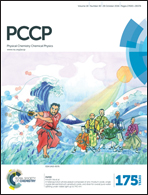Mechanistical investigation on the self-enhanced photocatalytic activity of CuO/Cu2O hybrid nanostructures by density functional theory calculations
Abstract
The photocatalytic mechanism of a Cu2O/CuO hybrid system is disclosed in detail by density functional theory (DFT) calculations. The synergistic relationship of the two counterparts is confirmed by hydrogen peroxide (H2O2) formation on the CuO nanowires and dissociation on the Cu2O nanoparticles; this enables the system to self-sufficiently produce hydroxyl radicals, which is highly efficient in the photocatalytic degradation of methyl orange. The exposed surfaces are found to be crucial in the cooperative photocatalytic system, especially the Cu2O(111) surface, in the dissociation of H2O2. The distinct positions of the conduction band minimum and valence band maximum for CuO and Cu2O and synergic surface reactions enable the effective utilization of the electrons and holes generated by visible-light irradiation. Our results will contribute to a greater understanding of the specific mechanism of photodegradation catalyzed by Cu2O/CuO heterostructures, which may lead to promising directions in structure optimization for photocatalysts with high photocatalytic efficiency.


 Please wait while we load your content...
Please wait while we load your content...